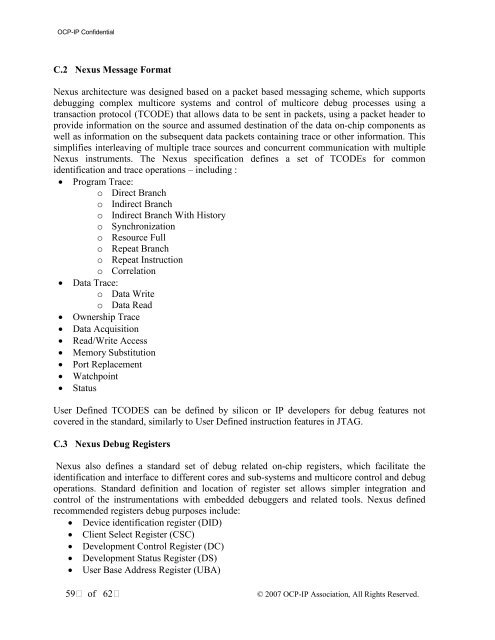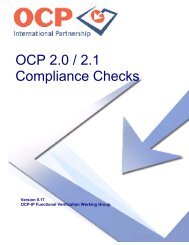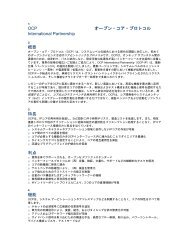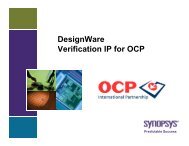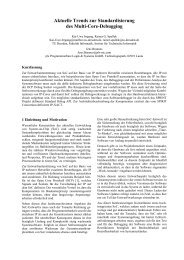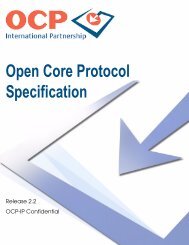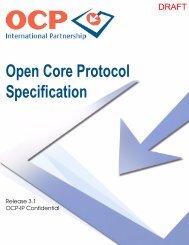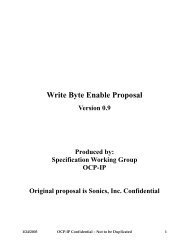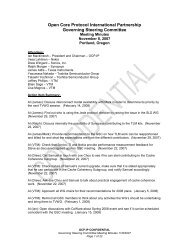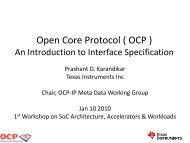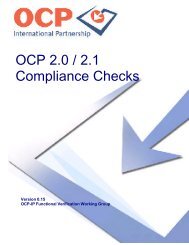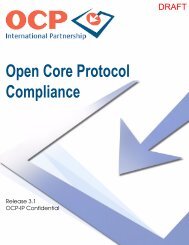Open Core Protocol Debug Interface Specification rev 1.0 - OCP-IP
Open Core Protocol Debug Interface Specification rev 1.0 - OCP-IP
Open Core Protocol Debug Interface Specification rev 1.0 - OCP-IP
You also want an ePaper? Increase the reach of your titles
YUMPU automatically turns print PDFs into web optimized ePapers that Google loves.
<strong>OCP</strong>-<strong>IP</strong> Confidential<br />
C.2 Nexus Message Format<br />
Nexus architecture was designed based on a packet based messaging scheme, which supports<br />
debugging complex multicore systems and control of multicore debug processes using a<br />
transaction protocol (TCODE) that allows data to be sent in packets, using a packet header to<br />
provide information on the source and assumed destination of the data on-chip components as<br />
well as information on the subsequent data packets containing trace or other information. This<br />
simplifies interleaving of multiple trace sources and concurrent communication with multiple<br />
Nexus instruments. The Nexus specification defines a set of TCODEs for common<br />
identification and trace operations – including :<br />
• Program Trace:<br />
o Direct Branch<br />
o Indirect Branch<br />
o Indirect Branch With History<br />
o Synchronization<br />
o Resource Full<br />
o Repeat Branch<br />
o Repeat Instruction<br />
o Correlation<br />
• Data Trace:<br />
o Data Write<br />
o Data Read<br />
• Ownership Trace<br />
• Data Acquisition<br />
• Read/Write Access<br />
• Memory Substitution<br />
• Port Replacement<br />
• Watchpoint<br />
• Status<br />
User Defined TCODES can be defined by silicon or <strong>IP</strong> developers for debug features not<br />
covered in the standard, similarly to User Defined instruction features in JTAG.<br />
C.3 Nexus <strong>Debug</strong> Registers<br />
Nexus also defines a standard set of debug related on-chip registers, which facilitate the<br />
identification and interface to different cores and sub-systems and multicore control and debug<br />
operations. Standard definition and location of register set allows simpler integration and<br />
control of the instrumentations with embedded debuggers and related tools. Nexus defined<br />
recommended registers debug purposes include:<br />
• Device identification register (DID)<br />
• Client Select Register (CSC)<br />
• Development Control Register (DC)<br />
• Development Status Register (DS)<br />
• User Base Address Register (UBA)<br />
59 of 62<br />
© 2007 <strong>OCP</strong>-<strong>IP</strong> Association, All Rights Reserved.


